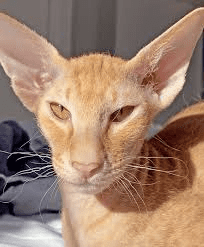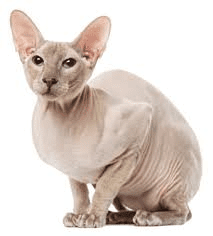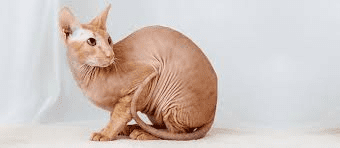A cat breed with Russian roots is the Peterbald cat, i.e. this breed was originated in Russian. Olga S. Mironova conducted an experimental breeding that resulted in its creation in St. Petersburg in 1994. With a gene for hair loss, they resemble Oriental Shorthairs. In 2009, the breed was permitted to compete in Championship classes.
Oriental Shorthairs and Peterbalds are similar. Due to a gene for hair loss, they can be born without hair, bald, flocked, brush-coated, or with a straight coat. Except for straight-coats, cats which are born with hair can lose their hair over time. They have all kinds of colors and markings.
The breed of the peterbald are lean and muscularly built. With almond-shaped eyes, a wedge-shaped muzzle, and large, spaced-apart ears, they have a long, slender head with a straight profile. Their oval paws, webbed feet, and long tail, which resembles a whip, enable them to grasp objects.
Peterbalds have a good sense of humor, are loving, peaceful, inquisitive, intelligent, and enthusiastic. They have a moderate vocal range, follow their owners, and seek out their company. Peterbalds typically get along with kids, other pets, and other cats.
A male Don Sphynx (Donskoy) and a female Oriental Shorthair were bred experimentally in 1994 by Olga S. Mironova. Four Peterbald kittens from these first two litters were born. These four kittens are thought to have started the breed.
Detailed History of the Peterbald Cat Breed

A cat breeder in St. Petersburg, Russia, made the decision in 1994 to develop a new breed that combined her two favorites’ best traits or type of cat.
Olga Mironova succeeded in breeding a hairless Donskoy with an Oriental Shorthair, resulting in a cat that looked like a Sphynx but was actually more closely related to an Oriental Shorthair with a hair-loss gene genetically.
In 1996, the Peterbald cat was admitted into the Russian Selectional Feline Federation (SFF). The World Cat Federation (WCF) officially recognized the breed in 2003 after receiving approval from the International Cat Association (TICA) in 1997.
In 2008, the Peterbald Award was accepted by the American Cat Fanciers Association (ACFA). Despite being relatively uncommon compared to other cat breeds, the breed is growing in popularity across the globe due to its exceptional personality.
Peterbalds are cute, loving, little cats. They follow you around the house to be as close to you as possible and are known for their dog-like loyalty to their favorite humans.
Their lively and inquisitive nature is complemented by their calm and docile disposition, making them a good choice for families with young children and other animals.
A medium-sized cat, the Peterbald has a wedge-shaped head, a long, lean body, and a tight abdomen. On the sides and tops of their heads, their ears are usually large, like rounded triangles that occupy a significant amount of space.
Read Also : Chocolate Point Siamese Cat Breed Description and Care Guide
Their large, nearly almond-shaped eyes are typically green in color and have a green tint. Long is the tail of the peterbald.
The Health Condition of the Peterbald Cats
Since many Peterbald cats lack hair, skin problems like sunburn, sensitivity to heat and cold, and other conditions could arise due to this skin exposure. They can also easily sustain injuries due to rough play with kids or playing with a cat companion.

If taken care of properly and given their scheduled vaccinations, these cats are associated with surprisingly few breed-specific health problems. A lifespan of 15 years or longer is typical for this breed.
The Peterbald cat, like all breeds, can be prone to weight-related conditions like obesity or heart disease, so they should be fed a high-protein, high-quality diet and get lots of exercise through playtime with their families.
The good news is that Peterbalds typically have a faster metabolism than cats with full coats, which results in them having healthy appetites. Their fast metabolism also helps them heal more quickly than fully-coated kitties when it comes to wounds or scratches than cats with full coats.
Peterbald Cats Upkeep and Grooming Guide

Despite having little or no even fur atall, Peterbald cats require a lot of routine care because of their high maintenance nature.
They don’t require frequent brushing, but they do require regular baths, probably once per week. Depending on how much fur each cat has, they may need to be bathed about once a week due to an accumulation of oil on their skin.
Read Also : British Blue Cat Breed Description and Care Guide
Natural oils in their skin and saliva will keep them hydrated and healthy, but taking regular baths will prevent those oils from accumulating and resulting in skin problems like acne in cats.
For Peterbalds, feeding can occasionally be a challenging problem. They may meow repeatedly throughout the day for food due to their higher than average metabolism. To keep your cat at a healthy weight, discuss feeding schedules with your veterinarian.
Like all cats, Peterbalds require regular nail trimming, ear cleanings, and litter box (feeding plates or water bowls) maintenance.
Peterbalds can pick up tricks just like dogs and are extremely intelligent. They adore nothing more than spending time playing with their owners and are up for any game involving toys or puzzles. These cats are active and extremely athletic.
The Peterbald is an excellent family pet due to its high level of activity and playfulness as well as its need for interaction with its family. The cat’s lack of fur makes it susceptible to injury, so playtime with kids or other animals should generally be supervised.
With regards to Peterbald cat price, finding Peterbald cat breeders for a kitten with a Peterbald gene may be challenging, and hairless cats are frequently sold for costly or high prices.
Peterbald cats are still relatively uncommon. If you want to learn more about finding this specific breed, speak to other Peterbald cat owners, reputable breeders, and rescue organizations.
In conclusion, Peterbald cats are incredibly talkative and active. They are a perceptive and self-reliant breed that will develop close relationships with all of their family members, including other cats.
Because they are affectionate and cuddly while also wanting to participate in daily household activities, these active cats are actually thought of as being somewhat “dog-like.” Additionally, they frequently speak to their owners using voices (meows), just like some dogs do (bark).
Read Also : General Impact of Wastes on Environment





